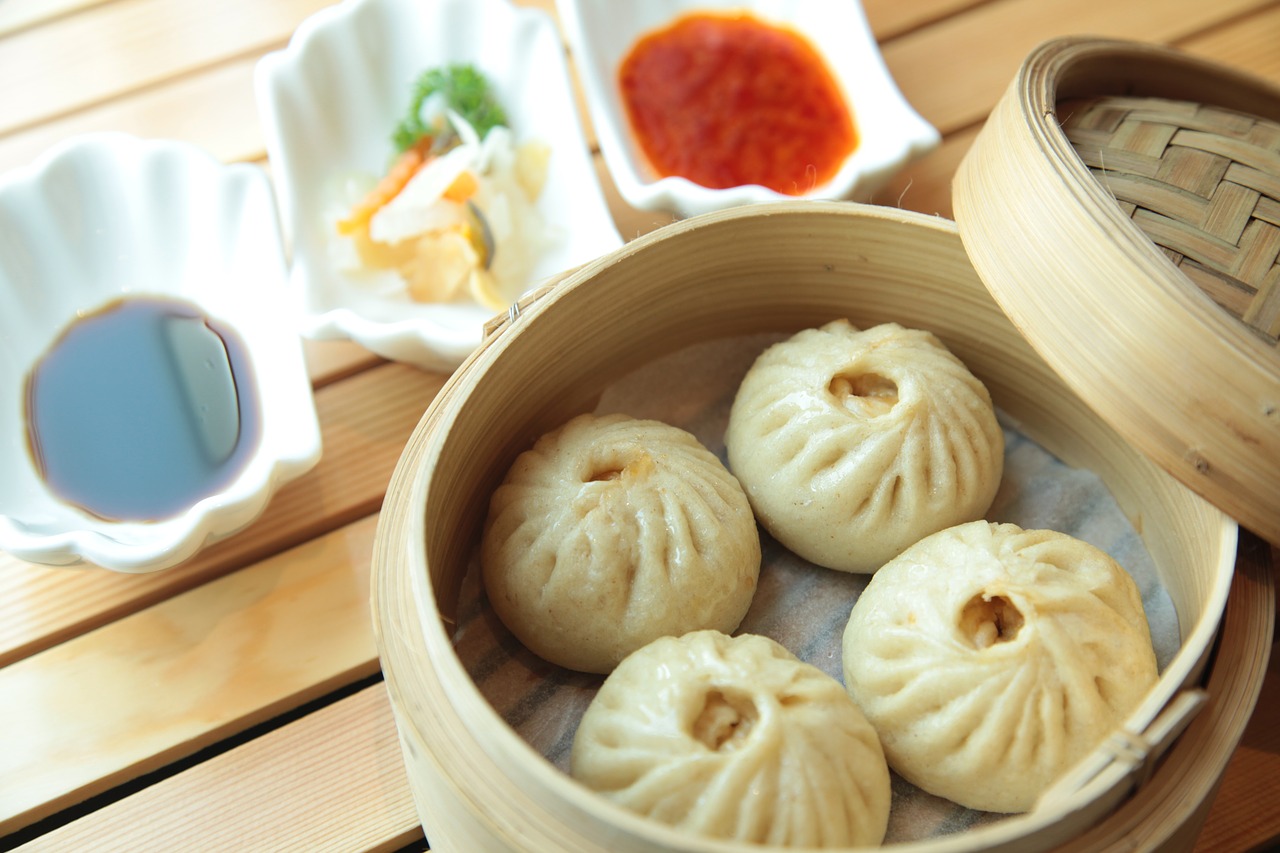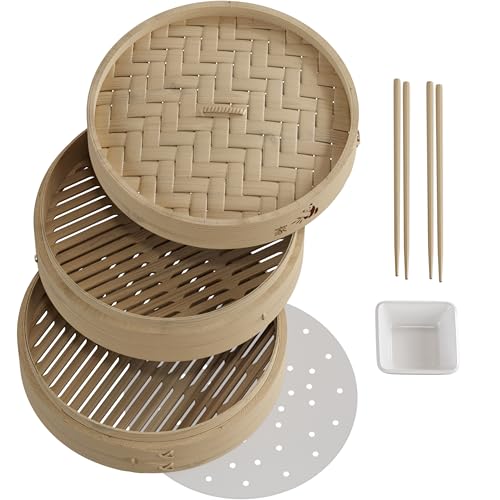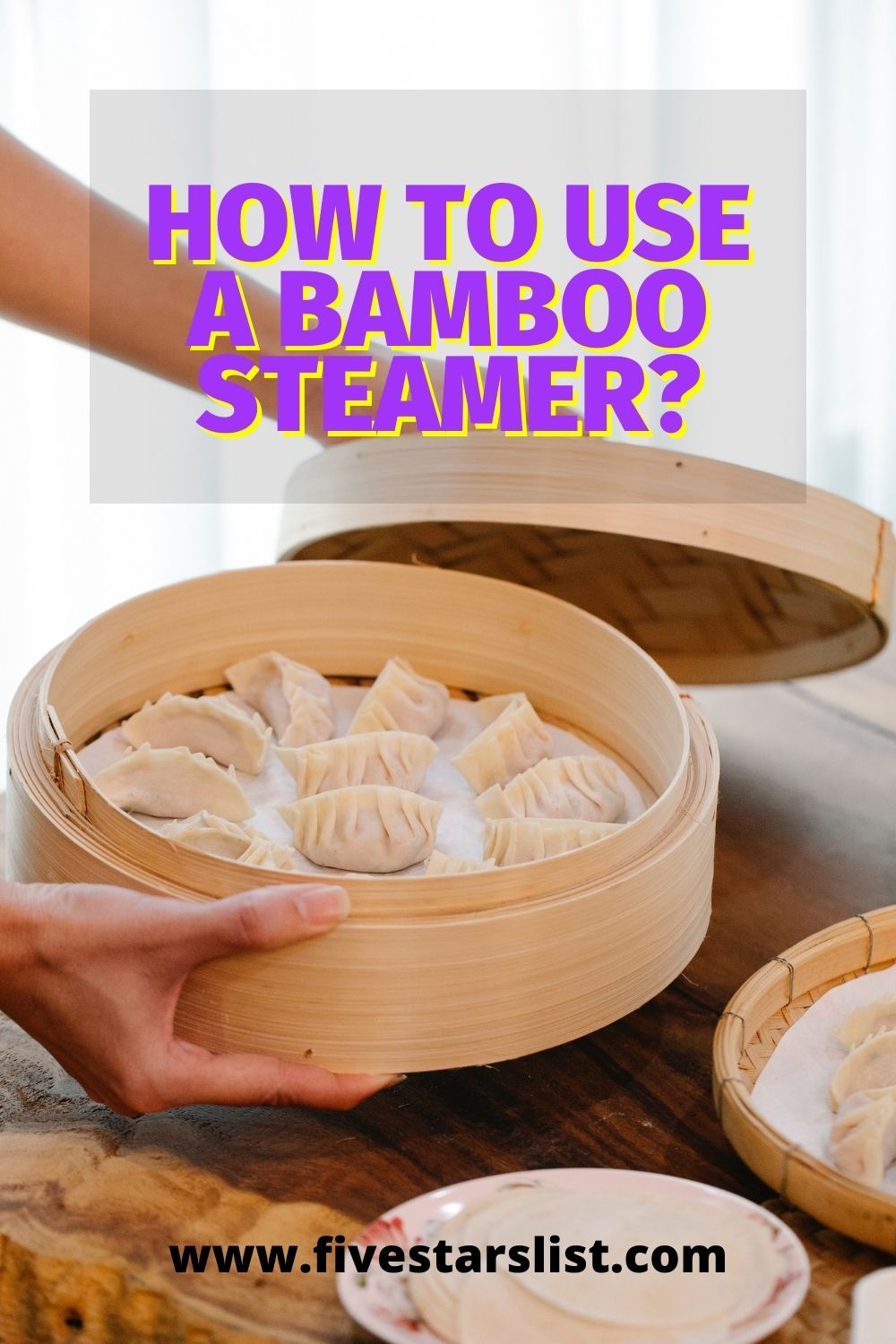As an Amazon Associate I earn from qualifying purchases.
According to opinion experts, steaming food is one of the healthiest ways of preparing food.

Image by Jonathan Valencia from Pixabay
What’s your first guess when you hear the word “steam”?
How about juicy vegetables, which are slowly cooking on steam?
Today we’re going to show you how to use a bamboo steamer for a healthier cooking method.
Bamboo steamers are traditionally used in Chinese cooking to steam fish, vegetables, and dumplings but it’s also versatile for all types of cuisines.
There are so many health benefits of steaming. It’s a kind of gentler approach to cooking and say boiling or poaching. It, also, preserves the vitamins and minerals from the food and it also retains the food flavor, shape, and color.
Although there are several types of steam cookware, our choice and recommendation is to use bamboo steamers.

We prefer the bamboo steamer over the steel one because the food just tastes better.
So, here I have our bamboo steamer, and as you can see it’s got two layers and this structure is what allows the steam to rise and cook the food.
| Preview | Product | |
|---|---|---|

|
Annie’s Kitchen Complete Set Handmade Bamboo Steamer Baskets, Lid Dumpling Maker with Spoon, 4... | Check Price |
Before you place any food we want to line a bamboo steamer so you can take parchment paper or you can use banana leaves or cabbage leaves.
The lining prevents the bamboo steamer from absorbing the flavors of the food.
We’re going to line this steamer and then we will place some bok choy in and then we’ll line the other one and also place some bok choy.
Just fold it in a little bit and then you can stack it up, and then place the lid and it’s ready to go.
The next step is to get a wide skillet or even a wok which works even better with bamboo steamers and you just want to add about 2 or 3 inches of water. You don’t want the water to be too high because you don’t want the water to touch the food.
Also, put the steamer inside the skillet or a wok right after you pour the water in, and then bring the water to a boil. Once it starts boiling reduce the flame to low and continue cooking until you completely steam the food.
The food will be cooked by the steam rising so pour in about 2 inches of water place your bamboo steamer in the center and make sure you have a skillet that’s wide enough so that the sides of the bamboo steamer do not touch the skillet.
Otherwise, it might burn and nobody wants fire. Then bring the flame to a boil and cook it for whatever time you need.
The result will be light healthy and delicious food.
Cleaning Bamboo Steamer
To clean your bamboo steamer don’t put it in the dishwasher, just use some warm water and mild soap and make sure you thoroughly dry it before you put it away to prevent damage.
A short history of steaming food
Steaming food is not a newly invented method. This way of cooking has been used for thousands of years.
Steaming food plays an important role in the life of many people of the world.
Rice – the main thing dish of the East – is the best when steamed!
The Chinese have been using steam cooking for over 3,000 years. Ancient stone steaming utensils have been found in Yunnan Province.
Later, the Chinese used leaf dishes for steaming, and today they use bamboo.
In India, modak – a ritual of offering food to Ganesha – includes steamed dumplings, stuffed with coconut and brown sugar.
Couscous is a famous dish made from steamed wheat semolina, which originates from Africa. This dish is described in the diary of Ibn Battuta – a great traveler and writer, who lived in the 14th century.
Couscous is still a favorite dish in Africa today, and it has become popular all over the world.
The benefits of steaming food
Cooking on steam is one of the healthiest methods of food preparation. But it’s not just that.
Steaming is a special way of preparing food, which allows the food to retain its original appearance, taste, color, and juice.
So, if you want to impress your friends with a fine, healthy, and professionally prepared meal – steam it!
Now, we’re going to list some of the benefits of steam cooking:
1. Steaming preserves the structure of the food
Many vegetables get cooked quickly and lose their shape. But if you’re steaming vegetables, you don’t have to worry about your vegetables turning into a puree.
Unlike other methods of food preparation, steaming does not destroy the cellular structure of foods and their original aroma.
2. Steaming preserves vitamins and minerals
When steaming food, the loss of vitamins and minerals from food is minimal.
For example, when steamed, broccoli loses only 11% of flavonoids. When you cook it in water, this loss is 66%, and when you cook it in the microwave – it’s a staggering 97%!
When steamed broccoli retains 80% of vitamin C, while when cooked in water – only 30%.
Therefore, if you want to eat food rich in natural vitamins and minerals, steam it or eat it raw.
3. Steaming preserves the taste, color, and juice of foods
By steaming, food retains its original color, flavor, freshness, and juiciness.
4. Steaming is a sophisticated way to add flavor to food
You can add various spices or stock the water you use for steaming. This way you can add amazing flavors and aromas to the food.
5. Steaming saves energy
Steaming allows you to prepare food in several layers at the same time, which saves energy.
In India, experienced housewives prepare the whole meal by steaming the food in special dishes in several layers.
6. No need to use oil – and the result is light and healthy food
It is not necessary to use oil when steaming. The result is a healthy, tasty, and light meal.
If you want, you can pour a few tablespoons of olive oil over the vegetables before serving.
7. You can steam almost everything – from vegetables to other foodstuffs
When we are talking about steaming, we think usually of vegetables.
But steaming is not limited to vegetables. You can steam any other grocery, too.
3 Ways of Steaming
Classic steaming
Groceries are put in a strainer, mesh, or special dish above boiling water. This way you can prepare fruits, vegetables, pasta, and many others groceries.
Steaming food in its juice
Wrap the food in baking paper, bamboo leaves (Chinese method), or banana leaves (Indian method) and place them over boiling water. The food will be steamed in its juice. This method is great for recipes that include marinating.
Steaming cereals
This is the traditional eastern way of steaming rice and other cereals.
Fry the rice briefly and pour boiling water over it. Add the salt, cover, and cook on low heat for 10-15 minutes, until the rice absorbs all the liquid. Then turn off the heat and let the rice stand for another 15-20 minutes.
You mustn’t lift the lid or stir the rice during cooking.
| Food: | Required time for steaming: |
| Broccoli, flowers | 4-6 min |
| Cabbage, grated | 5-8 min |
| Peas | 2-3 min |
| Kale | 12 min |
| Zucchini | 6-7 min |
| Asparagus | 8-10 min |
| Beans | 8-10 min |
| Carrots, sliced into sticks | 5-7 min |
| Cauliflower, flowers | 6-10 min |
| Eggplant, diced | 5-6 min |
| Pepper | 2-4 min |
| Green leafy vegetables | 3-5 min |
| Kohlrabi | 30-35 min |
| Onion, whole | 20-25 min |
| Mushrooms | 4-5 min |
| Tomato | 2-3 min |
| Potatoes, diced | 10-12 min |
The stated cooking time of vegetables refers to cooking in bamboo steamers. The cooking time of the vegetables in the other types of steamers may vary.
Image source: Amazon Product Advertising API
Amazon and the Amazon logo are trademarks of Amazon.com, Inc, or its affiliates.
Last update on 2024-10-23 / Affiliate links / Images from Amazon Product Advertising API





